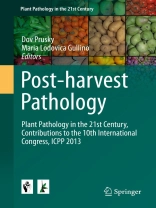This collection of papers includes some of the presentation given at the International congress of Plant Pathology held in Beijing in 2013 in the session of Recent Development in Postharvest Pathology. Fruit production for human consumption is an important part of the market economy. Any waste during to spoilage and pest infestation, in the field and the postharvest phase, results in significant economic losses which are more pronounced as the losses occur closer to the time of produce sale. Careful handling of perishable produce is needed for the prevention of postharvest diseases at different stages during harvesting. Handling, transport and storage in order to preserve the high quality produce. The extent of postharvest losses varies markedly depending on the commodities and country estimated to range between 4 and 8% in countries where postharvest refrigeration facilities are well developed to 30% where facilities are minimal. Microbial decay is one of the main factors that determine losses compromising the quality of the fresh produce. For the development of an integrated approach for decay management, cultural, preharvest, harvest and postharvest practices should be regarded as essential components that influence the complex interactions between host, pathogen, and environmental conditions. Orchards practices including preharvest fungicide applications can also directly reduce the development of postharvest fruit decay. Among postharvest practices, postharvest fruittreatments with fungicide are the most effective means to reduce decay. Ideally, these fungicides protect the fruit from infections that occur before treatment, including pathogen causing quiescent infections, as well from infection that are initiated after treatment during postharvest handling, shipment and marketing. The implementation of these alternatives techniques often requires modifying currently used postharvest practices and development of new formulation for their applications.
The present chapters deal with the newest report related to postharvest pathology in the world.
Daftar Isi
1: Molecular mechanism of a Rab/GTPase family genes Bcsas1 in pathogenicity ofBotrytis cinerea.- 2: p H modulation of host environment, a general mechanism modulating fugal attack in postharvest pathogen interactions.- 3: Exploring regulatory mechanisms of ambient p H on pathogenicity of postharvest pathogens using proteomics.- 4: The role of ROS ins ASM-induced disease resistance in Fuji Apples.- 5: Anthracnose and stem-end rots of tropical and subtropical fruit-new names for old foes.- 6: Preharvest management strategies for postharvest disease control in mango.- 7: Postharvest control of gray mold on blueberry based on critical growth stages and infections risk estimations.- 8: Improving radio frequency treatment for the control of stone fruit rots.- 9: Use of essential oil to control postharvest rots on apples and peaches.- 10:
Pichia anomala and
Candida oeophila in biocontrol of postharvest diseases of fruits:20 years of fundamental and practical research.- 11: Fungicide resistance in fruit of postharvest pathogens.












